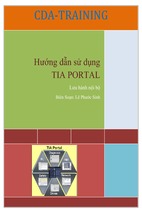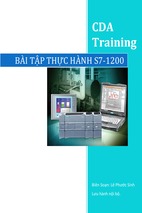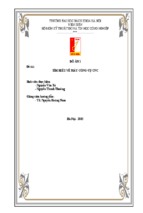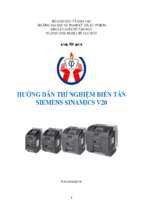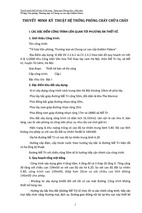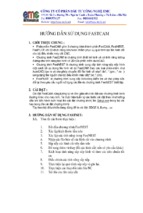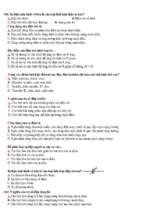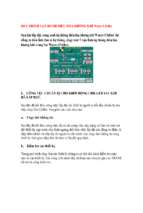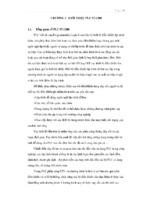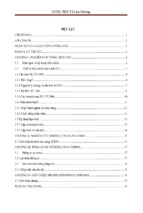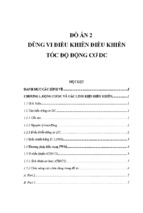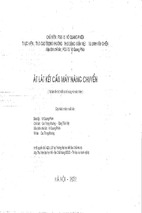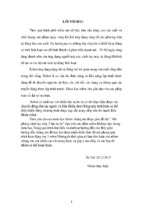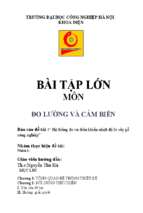điều khiển động cơ BLDC không dùng cảm biến hall
AN1160
Sensorless BLDC Control with Back-EMF Filtering
Using a Majority Function
Author:
Daniel Torres
Microchip Technology Inc.
INTRODUCTION
This application note describes a sensorless Brushless
Direct Current (BLDC) motor control algorithm that is
implemented using dsPIC® Digital Signal Controller
(DSC). The algorithm works utilizing a majority function
for digitally filtering the Back-Electromotive Force
(BEMF). Each phase of the motor is filtered to
determine when to commutate the motor drive
voltages. This control technique excludes the need for
discrete, low-pass filtering hardware and off-chip
comparators. It should be pointed out that all the
discussions here, and the application software,
assume a 3-phase motor has to be used. The motor
control algorithm described here has six main parts:
• Sampling trapezoidal BEMF signals using the
dsPIC Analog-to-Digital Converter (ADC)
• Reconstructing the Motor Virtual Neutral Point
• Comparing the trapezoidal BEMF signals to the
reconstructed motor virtual neutral point to detect
the zero crossing points
• Filtering the signals coming from the comparisons
using a majority function filter
• Commutate the motor driving voltages
• Control loop
The purpose of this application note is to explain the
different parts of the implementation of this new
sensorless BLDC motor control technique in a basic
and simple form. It also shows that this new control
method is a single-chip dsPIC DSC device-based
solution, which does not requires external hardware
except for a couple of resistors used to conditioning the
BEMF signals to the dsPIC DSC device ADC
operational voltage range.
© 2008 Microchip Technology Inc.
SENSORED CONTROL VERSUS
SENSORLESS CONTROL
The BLDC motor is used for both consumer and
industrial applications owing to its compact size,
controllability and high efficiency. Increasingly, it is also
used in automotive applications as a part of strategy to
eliminate belts and hydraulic systems, to provide
additional functionality and to improve fuel economy.
The continuing reduction in cost of magnets and the
electronics required for the control of BLDC motors has
contributed to its use in an increasing number of
applications and at higher power levels.
The BLDC motor is usually operated with one or more
rotor position sensors since the electrical excitation
must be synchronous to the rotor position. For reasons
of cost, reliability, mechanical packaging and especially
if the rotor runs immersed in fluid, it is desirable to run
the motor without position sensors, which is commonly
known as sensorless operation.
It is possible to determine when to commutate the
motor drive voltages by sensing the back-EMF voltage
on an undriven motor terminal during one of the drive
phases. The obvious cost advantage of sensorless
control is the elimination of the Hall position sensors.
Although there are some disadvantages to sensorless
control:
• The motor must be moving at a minimum rate to
generate sufficient back-EMF to be sensed
• Abrupt changes to the motor load can cause the
BEMF drive loop to go out of lock
• The BEMF voltage can be measured only when
the motor speed is within a limited range of the
ideal commutation rate for the applied voltage
• Commutation at rates faster than the ideal rate
will result in a discontinuous motor response
If low cost is a primary concern and low-speed motor
operation is not a requirement, and the motor load is
not expected to change rapidly, sensorless control may
be the better choice for your application. However,
there are specific algorithms to overcome all the
disadvantages listed above. The Sensorless BEMF
method is quickly becoming the most popular solution.
DS01160A-page 1
AN1160
SIX-STEP (Trapezoidal) Commutation
STEP COMMUTATION
The method for energizing the motor windings in the
sensorless algorithm described in this application note
is six-step trapezoidal or 120° commutation. Figure 1
shows how the six-step commutation works. Each step,
or sector, is equivalent to 60 electrical degrees. Six
sectors make up 360 electrical degrees, or one
electrical revolution.
• Step 1
- Red winding is driven positive.
- Green winding is driven negative.
- Blue winding is not driven.
• Step 2
- Red winding remains positive.
- Blue winding is driven negative.
- Green winding is not driven.
• Step 3
- Green winding is driven positive.
- Blue winding is driven negative.
- Red winding is not driven.
• Step 4
- Green winding is driven positive.
- Red winding is driven negative.
- Blue winding is not driven.
• Step 5
- Blue winding is driven positive.
- Red winding is driven negative.
- Green winding is not driven.
• Step 6
- Blue winding is driven positive.
- Green winding is driven negative.
- Red winding is not driven.
FIGURE 1:
SIX-STEP COMMUTATION
R
2
4
5
1
3
B
G
6
+VBUS
-VBUS
For every sector, two windings are energized and one
winding is not energized. The fact that one of the
windings is not energized during each sector is an
important characteristic of six-step control that allows
for the use of a sensorless control algorithm.
Red Winding
60°
This application note uses these terms to describe
motor speed:
• Electrical revolutions per minute (RPMElec)
• Electrical revolutions per second (RPSElec)
+VBUS
Green Winding
-VBUS
+VBUS
It is easier to discuss motor speed in these terms rather
than mechanical RPM because when talking about
electrical RPM, the number of motor poles need not be
factored in. The relationship between mechanical and
electrical RPM is seen in the following three equations:
Blue Winding
-VBUS
EQUATION 1:
1
2
3
4
5
6
Sector
The arrows in the winding diagram show the direction
in which the current flows through the motor windings
in each of the six steps. The graph shows the potential
applied at each lead of the motor during the six steps.
Sequencing through these six steps moves the motor
one electrical revolution.
DS01160A-page 2
M/E RPM RELATIONSHIP
2 ⋅ RPMElec
RPMMech = -------------------------------------------------------Number of Motor Poles
EQUATION 2:
E/M RPM RELATIONSHIP
RPMMech ⋅ Number of Motor Poles
RPMElec = ----------------------------------------------------------------------------------------2
© 2008 Microchip Technology Inc.
AN1160
EQUATION 3:
E/M RPS RELATIONSHIP
RPMElec
RPSElec = ------------------------60
BEMF Sensing Methods
When a BLDC motor rotates, each winding generates
BEMF which opposes the main voltage supplied to the
windings according to the Lenz’s law. The polarity of
this BEMF is in the opposite direction of the energizing
voltage. BEMF is mainly dependent on three motor
parameters:
• Number of turns in the stator windings
• Rotor’s Angular Velocity
• Magnetic field generated by rotor magnets
BEMF (in terms of motor parameters and angular
velocity) can then be calculated using the expression
given in Equation 4.
EQUATION 4:
BACK-EMF (BEMF)
BEMF = NlrBω
where
N = number of windings per phase
l = length of the rotor
r = internal radius of the rotor
B = rotor magnetic field
ω = angular velocity
As seen on the Equation 4, the only variable term is the
rotor angular speed. Therefore, the BEMF is
proportional to the rotor speed; as the speed increases
the BEMF increases.
The BEMF waveform of the motor varies as both a
function of the rotor’s position and speed. Detection of
position using the BEMF at zero and very low speeds
is, therefore, not possible. Nevertheless, there are
many applications (for example, fans and pumps) that
do not require positioning control or closed-loop
operation at low speeds. For these applications, a
BEMF method is very appropriate. There are many
different methods of using the BEMF. The majority of
these methods can be summarized as follows:
• Motor terminal voltage sensing
- Either by direct measurement or inference
(knowledge of switch states and DC bus voltage).
• Mid-point voltage sensing
- Only works for Y- and delta-connected motors
Certain classes of winding connections may not
work
- 4th wire not actually required. Can recreate star
point using the three motor phases
• Bus current gradient sensing
- Relies on characteristic bus current shape due to
commutation changing as rotor leads or lags
- Cannot use fast bus current control
© 2008 Microchip Technology Inc.
THE SELECTED BEMF SENSING METHOD
This application note is based on the Mid-Point voltage
reconstruction and is also based on detecting the
instances when the BEMF of an inactive phase is zero.
Therefore, it is important to mention that the BEMF
sensing method described in this application note can
only be implemented using trapezoidal BEMF signals
in order to have zero crossing events.
One important feature of this sensing method is the fact
that only a few external components are required to
determine the zero crossing points. Apart from the
BEMF signal conditioning and the power switch gate
drivers, the implementation is single-chip with the
dsPIC DSC device providing all of the control
functionality.
The BEMF zero-crossing technique was chosen
because of the following reasons:
• It is suitable for use on a wide range of motors.
• It can be used on both Y- and delta-connected
3-phase motors in theory. Certain classes of
connected motors may not work.
• It requires no detailed knowledge of motor
properties.
• It is relatively insensitive to motor manufacturing
tolerance variations.
• It will work for either voltage or current control.
• The zero-crossing technique is suitable for a wide
range of applications where closed-loop operation
near zero speed is not required. Provided the
speed is greater than zero, there are only two
positions per electrical cycle when the BEMF of a
phase is zero, and these positions can be
distinguished by the slope of the BEMF through
the zero crossing as shown in Figure 2.
FIGURE 2:
ZERO CROSSING
DETECTION
30°
0
0
0
SECTOR
5
0
1
2
3
4
5
0
1
= BEMF Zero Crossing
DS01160A-page 3
AN1160
Each sector corresponds to one of six equal 60º
portions of the electrical cycle (the sector numbering is
completely arbitrary). Commutations occur at the
boundary of each of the sectors. Therefore, it is the
sector boundaries that need to be detected. There is
a 30º offset between the BEMF zero-crossings and
required commutation positions, which must be
compensated for to ensure efficient and smooth
operation of the motor.
Assume that the motor is in the commutation Step 1
(according to Figure 1), in which Phase A is connected
to +VBUS through an electronic switch and Phase C is
connected to -VBUS through an electronic switch and
Phase B is open. The BEMF signal observed on
Phase B has a negative slope and its maximum value
is almost equal to +VDC just before the commutation
Step 2 occurs. The Phase B reaches the +VDC value
when the commutation Step 2 occurs.
Figure 2 also shows the individual idealized phase
BEMF waveforms. Assuming only the three motor
leads are available for sensing the BEMF, then the
voltage of the star point of the motor must be
determined because the BEMF waveform will be offset
by the star point voltage.
At that moment, Phase B is now connected to +VDC
through an electronic switch, Phase A is now open and
Phase C remains connected to -VDC. The BEMF signal
observed on Phase A has a positive slope and its
minimum value is almost equal to -VDC just before the
commutation Step 3 occurs. Both slopes observed on
Phase B and Phase A are compared to VDC/2 in order
to determine the zero crossing event. This circuitry is
easy to implement with three operational amplifiers
configured as comparators.
BEMF ZERO CROSSING SENSING METHODS
BEMF voltage zero-crossing signals can be detected
by different methods. This section describes two
different sensing methods. All of these methods have
advantages and as well as drawbacks, which will be
discussed in the next section. All these methods are
based on the fact that most of the times the motor
neutral point is not available, due to the fact that either
it was not wired or the motor windings were built in a
delta mode.
Comparing the BEMF Voltage to Half the DC Bus
Voltage
This method consists of comparing the BEMF voltage
to half the DC bus voltage by using comparators
assuming that the zero crossing events occur when the
BEMF is equal to VDC/2. Figure 3 shows the circuitry
used to implement this method.
FIGURE 3:
BEMF VOLTAGE
COMPARED TO HALF OF
THE DC BUS
DC+
A
Back-EMF
The drawbacks of this method are:
• This method assumes that the motor windings
parameters are identical.
• The sensed BEMF signals have positive and
negative phase shifts.
• Motor-rated voltage is less than the VDC voltage
most of the time; therefore, the zero crossing
event not always occurs at VDC/2.
Comparing the BEMF Voltage to the Motor
Neutral Point
The zero crossing sensing method described before
can be improved by having a variable threshold voltage
point used to detect the zero crossing events. This
variable voltage is in fact the motor neutral point. Often,
the motor manufacturers do not wire the motor neutral
point. However, it can be generated by using a resistor
network. Three networks are connected in parallel with
the motor windings and connected together to generate
a virtual neutral point. These connections are shown in
Figure 4.
FIGURE 4:
BEMF VOLTAGE
COMPARED TO A VIRTUAL
NEUTRAL POINT
A
DC- C
B
+
Back-EMF
To IC2
_
DC/2
C
DC-
B
+
_
Virtual Neutral
DS01160A-page 4
To IC2
© 2008 Microchip Technology Inc.
AN1160
The method used in this application note is based on
the same principle. However, the neutral point signal is
reconstructed by software. The neutral voltage is equal
to the average of the BEMF signals. Therefore, the
zero crossing threshold value is expressed in
Equation 5.
EQUATION 5:
The implementation of this method by software is
discussed in the further sections. The challenges of this
method consist of determining the correct time where
the BEMF signals should be sampled since the
samples acquired by the ADC may be affected by the
resonant transition voltages caused by the PWM
switching frequency. These samples may be also
affected by the kickback currents produced by the
windings de-energization. Figure 6 shows the BEMF
signals and the motor virtual neutral point. Figure 7
shows the BEMF signals and the reconstructed virtual
neutral point.
VIRTUAL NEUTRAL POINT
AND BEMF SIGNALS
RELATIONSHIP
BEMF A + BEMF B + BEMF C
Vn = ---------------------------------------------------------------------------3
The advantage of this method is that it is more flexible
in terms of measurement. When the speed varies, the
winding characteristics may fluctuate, resulting in
variation of the BEMF. In such situations the dsPIC
DSC device has complete control over the
determination of the zero crossing point. A digital filter
is implemented to filter out the high-frequency
switching noise components from the BEMF signal.
where
Vn is motor neutral voltage
BEMF A is the BEMF voltage observed in Phase A
BEMF B is the BEMF voltage observed in Phase B
BEMF C is the BEMF voltage observed in Phase C
Then the reconstructed motor neutral voltage is
compared to each BEMF signal to determine the zero
crossing events. A zero crossing event occurs when
the BEMF signals are equal to the motor neutral point.
Figure 5 shows the BEMF signals measured with the
ADC.
FIGURE 5:
BEMF VOLTAGE MEASURED USING THE dsPIC® DSC ADC
dsPIC30F2010
BLDC
PWM3H
PWM3L
PWM2H
PWM2L
PWM1H
PWM1L
FLTA
3-Phase
Inverter
Fault
R49
R41
R34 R36
R44
AN2
R52
Demand
AN3
AN4
AN5
© 2008 Microchip Technology Inc.
Phase Terminal Voltage Feedback
DS01160A-page 5
AN1160
FIGURE 6:
BEMF SIGNALS VERSUS VIRTUAL NEUTRAL POINT WHEN THE PWM DUTY
CYCLE IS EQUAL TO 100%
3.00
2.50
Voltage
2.00
1.50
1.00
0.50
0.00
Time
PHASE A
FIGURE 7:
PHASE B
PHASE C
NEUTRAL
BEMF SIGNALS VERSUS RECONSTRUCTED VIRTUAL NEUTRAL POINT WHEN
THE PWM DUTY CYCLE IS EQUAL TO 100%
3.00
2.50
Voltage
2.00
1.50
1.00
0.50
0.00
Time
PHASE A
DS01160A-page 6
PHASE B
PHASE C
RECONS
© 2008 Microchip Technology Inc.
AN1160
Required Hardware
The following hardware is required to run the BLDC
motor control method described in this application note:
dsPIC30F SOFTWARE VERSION
• PICDEM™ MCLV Development Board (Figure 8)
• Hurst DMB0224C10002 CL B 6403 24V BLDC
Motor
• 24 VDC Power Supply
FIGURE 8:
PICDEM™ MCLV DEVELOPMENT BOARD
© 2008 Microchip Technology Inc.
DS01160A-page 7
AN1160
dsPIC33F SOFTWARE VERSION
• dsPIC33FJ12MC202 PIM
• Explorer 16 Development Board
• Motor Control Interface PICtail™ Plus Daughter
Board
• dsPICDEM™ MC1L 3-Phase Low Voltage Power
Module
• Hurst DMB0224C10002 CL B 6403 24 V BLDC
Motor
• 24 VDC Power Supply
FIGURE 9:
HARDWARE CONNECTIONS FOR THE dsPIC33F SOFTWARE VERSION
These items can be purchased from Microchip as a
complete kit or as individual components. Refer to the
Development Tools section on the Microchip website
for ordering information.
DS01160A-page 8
© 2008 Microchip Technology Inc.
AN1160
Hardware Modifications
The hardware block diagram previously shown in
Figure 5 is a simplified block diagram of this motor
control application. It shows the basic connections
needed to get this algorithm work.
The required connections to get the hardware
configuration shown in Figure 5 on the MCLV board are
done through the jumper settings listed in Table 1.
TABLE 1:
The
required
connections
to
achieve
the
dsPIC33FJ12MC202 hardware configuration shown in
Figure 5 are listed below.
The default hardware configuration for the
dsPIC33FJ12MC202 PIM must be modified to match
the configuration shown in Table 2.
TABLE 2:
PIM RESISTORS
CONFIGURATION
Resistor
MCLV JUMPER
CONFIGURATION
Jumper
Setting
J8
Open
J10
Open
J12
Open
J14
Open
J19
Open
J7
Short in position 2 - 3
J11
Short in position 2 - 3
J13
Short in position 2 - 3
J15
Short in position 2 - 3
J16
Short
J17
Short
R29, R30, R8, R6, R20,
R31, R27, R25, R9, R7,
R5
R15, R16, R17, R18,
R19, R32, R33, R14,
R10, R23, R22, R21,
R28, R26, R24, R13,
R11, R12
Setting
Not populated
Populated
The default hardware configuration for the Explorer 16
Development Board must be modified to match the
configuration shown in Table 3.
TABLE 3:
EXPLORER 16 JUMPERS AND
RESISTORS CONFIGURATION
Hardware modification
Setting
These jumper settings used to configure the MCLV
board are as follows:
Jumper JP2
Jumper J7
Short in position PIC24
• Pot R14 selects the demand for the speed. It is
connected to the dsPIC DSC ADC channel AN4.
• BEMF signals are sensed using resistor networks
R34/R36/R35, R41/R44/R42 and R49/R52/R50.
The BEMF Phase A, B, and C signals are applied
to the ADC channels AN3, AN4, and AN5
respectively.
• The capacitors C17, C19, and C21 used to filter
the BEMF signals are disconnected since all the
BEMF filtering is done by software.
• Fault input is received through a comparator
circuit (U7D) connected with the current feedback
circuit. The current is sensed using a 0.1Ω
resistor (R26). The threshold point of the
comparator can be adjusted using pot R60.
Switch S2
Short in postion PIM
© 2008 Microchip Technology Inc.
Short
Resistors R50, R51, R52
Not populated
The default hardware configuration for the Motor
Control Interface PICtail™ Plus Daughter Board must
be modified to match the configuration shown in
Table 4.
TABLE 4:
MOTOR CONTROL INTERFACE
PICtail™ PLUS DAUGHTER
BOARD JUMPER
CONFIGURATION
Jumper
Setting
J12, J11, J10
Open
J1, J4
Open
J14, J15, J16
Open
J17
Short
J6, J7, J8
Open
J13
Open
DS01160A-page 9
AN1160
The default hardware configuration of the
37W_DTYPE_PLUG LK resistors in the dsPICDEM™
MC1L 3-Phase Low Voltage Power Module must be
configured as shown in Table 5.
Warning: Removing the top of the metal enclosure
may result in electric shock. Wait at least
5 minutes after power is removed from the
module before contacting the PCB in the
enclosure. Follow the safety instructions
described in Section 1.6.2 “Accessing
the System” of the dsPICDEM™ MC1L
3-Phase Low Voltage Power Module
User’s Guide, before removing the top of
the metal enclosure.
TABLE 5:
dsPICDEM™ MC1L 3-PHASE
LOW VOLTAGE POWER
MODULE RESISTORS
CONFIGURATION
LK 51Ω resistors
Setting
LK22, LK24, LK25, LK26,
LK30
Populated
LK19, LK20, LK21, LK23,
LK27, LK28, LK29, LK31,
LK32
Not populated
This BEMF sensing method is based on a nonlinear
digital filter called ‘majority function’. In certain
situations it is also known as ‘median operator’. The
majority function is a Boolean function, which takes a
number n of binary inputs and returns the value which
is most common among them. For three Boolean
inputs, it returns whichever value (true or false) occurs
at least twice. In this case, two equal values represents
66% of the numbers. The majority function always
returns the value of the majority (> 50%) of the
numbers. Table 6 shows an example of a 3-inputs
majority function.
AN EXAMPLE OF A MAJORITY
FUNCTION USING THREE
INPUTS
A
B
C
Majority
1
1
1
1
1
1
0
1
1
0
1
1
1
0
0
0
0
1
1
1
0
1
0
0
0
0
1
0
0
0
0
0
DS01160A-page 10
EQUATION 6:
BOOLEAN
REPRESENTATION OF THE
MAJORITY FUNCTION
Majority = ( A ∧ B ) ∨ ( A ∧ C ) ∨ ( B ∧ C )
Implementing the Algorithm
In the earlier sections, it was pointed out that this BEMF
method is based on the detection of zero-crossing
events occurring on the BEMF signals. This section
explains the implementation of this algorithm by the
means of the dsPIC DSC device resources and
peripherals.
SAMPLING THE BEMF SIGNALS
Digital Filter (Majority Function)
TABLE 6:
The majority of the values can be expressed using two
logic operators, AND ( ^ ) and OR ( v ) operators, as
shown in Equation 6.
The first task to be performed is sampling the BEMF
signals. To achieve such a task, the dsPIC DSC ADC is
configured in such a way that it simultaneously
samples the BEMF signals at a sampling rate equal to
the PWM reload frequency; in this case it is 20 kHz.
Therefore, the ADC is synchronized with the PWM
reload event.
The dsPIC DSC ADC is also configured to take
samples at the PWM ON time with the purpose of
avoiding the ringing noise produced by the electronic
switches and other noises such as the high voltage
spikes produced by the winding de-energization event.
These noises could create false zero-crossing events
and therefore, a false commutation state.
The point in which the signals are sampled is variable
across the PWM ON time depending on the motor
speed. At low speeds, the dsPIC DSC device samples
the BEMF signals at 50% of the PWM ON time.
However, the sampling point moves forward according
to the PWM duty cycle to reach the maximum point of
75% of the PWM ON time when the PWM duty cycle is
equal to 100%. Figure 10 and Figure 11 illustrate the
sampling points.
The motor neutral point is then reconstructed by
software using the sampled BEMF signals A, B, and C.
This reconstructed signal is compared against the
sampled BEMF signals to identify the zero-crossing
events. At this point, the external comparators have
been emulated by software; the output of these
software comparators are the binary representation of
the sampled BEMF signals. The produced signals with
these software comparisons still have some noise
produced by the winding de-energization events, and
the ringing noise produced by the electronic switches.
© 2008 Microchip Technology Inc.
AN1160
Sampling the BEMF signals at 20 kHz significantly
reduces the switching noise on the sampled BEMF
signals; consequently, it is easier to detect the zero
crossing events. However, this aliasing trick is not
enough to completely filter the BEMF signals.
Therefore, the majority function filter is used.
FIGURE 10:
BEMF SAMPLING POINTS AT 80% OF DUTY CYCLE
BEMF Sampling Point
BEMF Signal
PWM Signal
© 2008 Microchip Technology Inc.
DS01160A-page 11
AN1160
FIGURE 11:
BEMF SAMPLING POINTS AT 20% OF DUTY CYCLE
BEMF Sampling Point
BEMF Signal
PWM Signal
DS01160A-page 12
© 2008 Microchip Technology Inc.
AN1160
FILTERING THE BEMF SIGNALS USING THE
MAJORITY FUNCTION FILTER
• The last 32 values are filled out using Equation 8.
The implementation of this nonlinear filter is
based on a 6-samples window in which at least
51% of the three most significant samples should
be equal to “1” and the three least significant
samples should be equal to “0” for the purpose of
identifying the occurrence of a zero-crossing
event in the digitalized BEMF signals. This
filtering step results in a more robust algorithm.
EQUATION 8:
The first stage of the majority function filter is
implemented using two logic operators, an AND
operator for detecting the active BEMF signal
correspondingly to the existing commutation state, and
an Exclusive-OR (XOR) operator is used to detect the
falling or rising edges on the active BEMF signal. The
output of this logic operation is called “the
active-masked BEMF signal” in the following sections.
TABLE 7:
The active-masked BEMF signal is then filtered using
the majority detection filter. This filter is implemented
with an array compounded by 64 values and a special
logic test condition that is used to modify the pointer of
the next data array. This logic test condition also
identifies both the falling and rising edges of the
active-masked BEMF signals; both edges are
represented as a true-to-false event at the output of the
logical test condition. The output of this condition is
also used as an input to the majority detection filter.
The 64 values represent the 26 possible combinations
that the 6-sample window could have for the active
masked BEMF signal; each value on the look-up table
is a pointer to the next signal state over time. The filter
is always looking for a true-to-false change at the
output of the logic test condition, if this true-to-false
condition is detected, the filter looks for three
consecutive false states to validate that a zero-crossing
event occurred. A true-to-false condition at the output
of the logic test represents a zero-crossing event and
therefore a commutation on the motor, which occurs
after a delay. This delay is equal to the timing of 30
electrical degrees minus the time required to execute
the digital filtering. After the commutation a new BEMF
signal is then monitored.
CALCULATING THE
SECOND HALF OF THE
ARRAY
Array Value [N] = ( N – 32 ) ⋅ 2
ARRAY VALUES
Array
Index [N]
Array
Value
Array
Index [N]
Array
Value
0
0
32
0
1
2
33
2
2
4
34
4
3
6
35
6
4
8
36
8
5
10
37
10
6
12
38
12
7
14
39
14
8
16
40
16
9
18
41
18
10
20
42
20
11
22
43
22
12
24
44
24
13
26
45
26
14
28
46
28
15
30
47
30
16
32
48
32
17
34
49
34
18
36
50
36
19
38
51
38
20
40
52
40
21
42
53
42
22
44
54
44
23
46
55
46
24
48
56
48
25
50
57
50
The 64 array values are determined as follows:
26
52
58
52
• The first 32 numbers are the index number
multiplied by two, as shown in Equation 7
27
54
59
54
28
56
60
56
29
58
61
58
30
60
62
60
31
62
63
62
EQUATION 7:
CALCULATING THE FIRST
HALF OF THE ARRAY
Array Value [N] = N ⋅ 2
© 2008 Microchip Technology Inc.
There are 16 unique array index numbers that
represent the true-to-false condition. These values are
listed in order of appearance 24, 25, 26, 28, 40, 41, 42,
44, 48, 49, 50, 52, 56, 57, 58, 60. The values pointed
by these unique indexes are replaced by “1” to indicate
that a true-to-false condition occurred.
DS01160A-page 13
AN1160
The 16 unique index values are selected using the
following majority function criteria. An array index
number is a unique value when its binary
representation contains a majority of “1” (> 50%) in the
three most significant bits followed by a majority
of “0” (> 50%) in the three least significant bits. Table 8
shows the 16 possible numbers that match these two
conditions.
TABLE 8:
16 UNIQUE NUMBERS THAT
NOTIFY A TRUE-TO-FALSE
CONDITION IN THE ACTIVE
MASKED BEMF
Number
6-bit Binary Representation
24
011000
25
011001
26
011010
28
011100
40
101000
41
TABLE 10:
NUMBERS THAT NEVER POINT
TO A UNIQUE VALUE
6-bit Binary
Rep.
Number
Numbers
Pointed Before
Becoming Zero
Number of
Times to
be
Right-Shift
ed
1
000001
2, 4, 8, 16, 32
5
9
001001
18, 36, 8, 16, 32
5
36
100100
8, 16, 32
3
17
010001
34, 4, 8, 16, 32
5
The complete filter coefficients are shown in Table 11.
TABLE 11:
MAJORITY FILTER
COEFFICIENTS
Array
Array
Array
(Unique
Index
Value
Numbers)
[N]
Array
Index
[N]
Array
Value
Array
(Unique
Numbers)
101001
0
0
0
32
0
0
42
101010
1
2
2
33
2
2
44
101100
2
4
4
34
4
4
110000
3
6
6
35
6
6
49
110001
4
8
8
36
8
8
50
110010
5
10
10
37
10
10
52
110100
6
12
12
38
12
12
56
111000
7
14
14
39
14
14
57
111001
8
16
16
40
16
1
58
111010
9
18
18
41
18
1
60
111100
10
20
20
42
20
1
11
22
22
43
22
22
12
24
24
44
24
1
13
26
26
45
26
26
14
28
28
46
28
28
15
30
30
47
30
30
16
32
32
48
32
1
48
The 48 remaining array numbers are pointers to the
unique values in case a true-to-false condition occurs.
There are some values that never point to any of the
unique values because they are not multiple of any of
the 16 unique numbers. Table 9 provides some
numbers that match this condition.
TABLE 9:
Number
NUMBERS THAT ARE A
MULTIPLE OF A UNIQUE
NUMBER
6-bit
Binary
Rep.
Number
of Times
to be
Right-Shi
fted
Unique
Number
to be
Pointed
6-bit
Binary
Rep. of
Unique
Number
3
000011
3
24
011000
11
001011
3
24
011000
54
7
110110
000111
1
2
44
28
101000
011100
Those numbers (that never point to a 16 unique
number) are then pointed to its multiple and they are
trapped into a loop in such a way that the filter is waiting
for a new value, which points to a unique number.
Table 10 shows the numbers that are not multiple of a
unique value.
DS01160A-page 14
17
34
34
49
34
1
18
36
36
50
36
1
19
38
38
51
38
38
20
40
40
52
40
1
21
42
42
53
42
42
22
44
44
54
44
44
23
46
46
55
46
46
24
48
1
56
48
1
25
50
1
57
50
1
26
52
1
58
52
1
27
54
54
59
54
54
28
56
1
60
56
1
29
58
58
61
58
58
30
60
60
62
60
60
31
62
62
63
62
62
© 2008 Microchip Technology Inc.
AN1160
Table 12 shows an example of the complete filtering
process. The inputs are the noiseless binary
representation of the BEMF signals. Table 13 shows an
example of the complete filtering process. In this case,
the inputs are the noisy binary representation of the
BEMF signals.
EXAMPLE OF DIGITAL FILTERING COMPUTATIONS USING NOISELESS BEMF
SIGNALS
B
A
C
B
A
C
B
A
ZERO-CROSSING EVENT
AND
MASK
0
1
1
0
0
0
0
0
0
0
0
0
0
FALSE
000
000
3
1
1
0
0
0
0
0
1
0
1
1
0
FALSE
010
000
6
1
1
0
0
0
0
0
1
0
1
1
2
FALSE
001
111
9
1
1
0
0
0
0
0
1
0
1
1
6
FALSE
100
000
12
1
1
0
0
0
0
0
1
0
1
1
14
FALSE
010
111
15
1
1
0
0
0
0
0
1
0
1
1
30
FALSE
001
000
18
1
1
0
0
0
0
0
1
0
1
1
62
FALSE
100
111
21
1
1
0
0
0
0
0
1
0
1
1
62
FALSE
000
000
24
1
1
0
0
0
0
0
1
0
1
1
62
FALSE
—
—
27
1
1
0
0
0
0
0
1
0
1
1
62
FALSE
—
—
30
1
1
0
0
0
0
0
1
0
1
1
62
FALSE
—
—
33
1
1
0
0
0
0
0
1
0
1
1
62
FALSE
—
—
36
1
1
0
0
0
0
0
1
0
1
1
62
FALSE
—
—
39
1
1
0
0
0
0
0
1
0
1
1
62
FALSE
—
—
42
1
1
0
0
0
0
0
1
0
1
1
62
FALSE
—
—
45
1
1
0
0
0
0
0
1
0
1
1
62
FALSE
—
—
48
1
1
0
0
0
0
0
1
0
1
1
62
FALSE
—
—
51
1
1
0
0
0
0
0
1
0
1
1
62
FALSE
—
—
54
1
1
0
0
0
0
0
1
0
1
1
62
FALSE
—
—
57
1
1
0
0
0
0
0
1
0
1
1
62
FALSE
—
—
60
1
0
0
0
0
0
0
1
0
0
1
62
FALSE
—
—
63
1
0
0
0
0
0
0
1
0
0
1
60
FALSE
—
—
66
1
0
0
0
0
0
0
1
0
0
1
1
FALSE
—
—
69
1
0
0
0
0
0
0
1
0
0
1
2
TRUE
—
—
72
1
0
0
1
1
1
0
0
1
1
2
4
FALSE
—
—
75
1
0
0
1
1
1
0
0
1
1
2
10
FALSE
—
—
78
1
0
0
1
1
1
0
0
1
1
2
22
FALSE
—
—
81
1
0
0
1
1
1
0
0
1
1
2
46
FALSE
—
—
ELECTRICAL ANGLE
C
DIGITAL FILTER OUTPUT
AND-Masked
Phase
COMMUTATION STEP
XOR-Masked
Phase
LOGICAL TEST CONDITION
TABLE 12:
BEMF Phase
XOR
MASK
84
1
0
0
1
1
1
0
0
1
1
2
30
FALSE
—
—
87
1
0
0
1
1
1
0
0
1
1
2
62
FALSE
—
—
© 2008 Microchip Technology Inc.
DS01160A-page 15
AN1160
EXAMPLE OF DIGITAL FILTERING COMPUTATIONS USING NOISELESS BEMF
SIGNALS (CONTINUED)
B
A
C
B
A
C
B
A
ZERO-CROSSING EVENT
AND
MASK
90
1
0
0
1
1
1
0
0
1
1
2
62
FALSE
—
—
93
1
0
0
1
1
1
0
0
1
1
2
62
FALSE
—
—
96
1
0
0
1
1
1
0
0
1
1
2
62
FALSE
—
—
99
1
0
0
1
1
1
0
0
1
1
2
62
FALSE
—
—
102
1
0
0
1
1
1
0
0
1
1
2
62
FALSE
—
—
105
1
0
0
1
1
1
0
0
1
1
2
62
FALSE
—
—
108
1
0
0
1
1
1
0
0
1
1
2
62
FALSE
—
—
111
1
0
0
1
1
1
0
0
1
1
2
62
FALSE
—
—
114
1
0
0
1
1
1
0
0
1
1
2
62
FALSE
—
—
117
1
0
0
1
1
1
0
0
1
1
2
62
FALSE
—
—
120
1
0
1
1
1
1
0
0
1
0
2
62
FALSE
—
—
123
1
0
1
1
1
1
0
0
1
0
2
60
FALSE
—
—
126
1
0
1
1
1
1
0
0
1
0
2
1
FALSE
—
—
129
1
0
1
1
1
1
0
0
1
0
2
2
TRUE
—
—
132
1
0
1
0
0
0
1
0
0
1
3
4
FALSE
—
—
ELECTRICAL ANGLE
C
DIGITAL FILTER OUTPUT
AND-Masked
Phase
COMMUTATION STEP
XOR-Masked
Phase
LOGICAL TEST CONDITION
TABLE 12:
BEMF Phase
DS01160A-page 16
XOR
MASK
© 2008 Microchip Technology Inc.
AN1160
B
A
C
B
A
AND-Masked
Phase
C
B
A
ZERO-CROSSING EVENT
C
XOR-Masked
Phase
DIGITAL FILTER OUTPUT
BEMF Phase
COMMUTATION STEP
EXAMPLE OF DIGITAL FILTERING COMPUTATIONS USING NOISY BEMF
SIGNALS
LOGICAL TEST CONDITION
ELECTRICAL ANGLE
TABLE 13:
AND
MASK
XOR
MASK
0
1
1
0
0
0
0
0
0
0
0
0
0
FALSE
000
000
3
1
1
0
0
0
0
0
1
0
1
1
0
FALSE
010
000
6
1
0
1
0
0
0
0
1
0
0
1
2
FALSE
001
111
9
1
1
0
0
0
0
0
1
0
1
1
4
FALSE
100
000
12
1
1
0
0
0
0
0
1
0
1
1
10
FALSE
010
111
15
0
1
1
0
0
0
0
1
0
1
1
22
FALSE
001
000
18
1
1
0
0
0
0
0
1
0
1
1
46
FALSE
100
111
21
1
0
0
0
0
0
0
1
0
0
1
1
FALSE
000
000
24
1
1
0
0
0
0
0
1
0
1
1
2
FALSE
—
—
27
1
1
0
0
0
0
0
1
0
1
1
6
FALSE
—
—
30
1
1
0
0
0
0
0
1
0
1
1
14
FALSE
—
—
33
1
1
1
0
0
0
0
1
0
1
1
30
FALSE
—
—
36
0
1
0
0
0
0
0
1
0
1
1
62
FALSE
—
—
39
1
1
0
0
0
0
0
1
0
1
1
1
FALSE
—
—
42
1
1
0
0
0
0
0
1
0
1
1
2
FALSE
—
—
45
1
0
0
0
0
0
0
1
0
0
1
6
FALSE
—
—
48
1
1
0
0
0
0
0
1
0
1
1
12
FALSE
—
—
51
1
1
0
0
0
0
0
1
0
1
1
26
FALSE
—
—
54
1
1
0
0
0
0
0
1
0
1
1
54
FALSE
—
—
57
1
1
0
0
0
0
0
1
0
1
1
1
FALSE
—
—
60
1
0
0
0
0
0
0
1
0
0
1
2
TRUE
—
—
63
1
1
0
1
1
1
0
0
1
1
2
4
FALSE
—
—
66
0
0
0
1
1
1
0
0
1
1
2
10
FALSE
—
—
69
1
1
1
1
1
1
0
0
1
0
2
22
FALSE
—
—
72
1
1
0
1
1
1
0
0
1
1
2
44
FALSE
—
—
75
0
0
0
1
1
1
0
0
1
1
2
1
FALSE
—
—
78
1
0
1
1
1
1
0
0
1
0
2
2
FALSE
—
—
81
1
0
0
1
1
1
0
0
1
1
2
4
FALSE
—
—
84
0
1
0
1
1
1
0
0
1
1
2
10
FALSE
—
—
87
1
0
1
1
1
1
0
0
1
0
2
22
FALSE
—
—
90
0
1
0
1
1
1
0
0
1
1
2
44
FALSE
—
—
93
1
0
0
1
1
1
0
0
1
1
2
1
FALSE
—
—
96
1
0
1
1
1
1
0
0
1
0
2
2
FALSE
99
1
1
0
1
1
1
0
0
1
1
2
4
FALSE
—
—
102
1
0
0
1
1
1
0
0
1
1
2
10
FALSE
—
—
© 2008 Microchip Technology Inc.
DS01160A-page 17
AN1160
EXAMPLE OF DIGITAL FILTERING COMPUTATIONS USING NOISY BEMF
SIGNALS (CONTINUED)
XOR-Masked
Phase
AND-Masked
Phase
1
0
0
1
1
1
0
0
1
1
2
22
FALSE
—
—
1
1
1
1
1
1
0
0
1
0
2
46
FALSE
—
—
B
A
C
B
A
C
B
A
DIGITAL FILTER OUTPUT
105
108
C
COMMUTATION STEP
AND
MASK
ELECTRICAL ANGLE
ZERO-CROSSING EVENT
BEMF Phase
LOGICAL TEST CONDITION
TABLE 13:
XOR
MASK
111
1
0
0
1
1
1
0
0
1
1
2
1
FALSE
—
—
114
1
1
0
1
1
1
0
0
1
1
2
2
FALSE
—
—
117
1
0
0
1
1
1
0
0
1
1
2
6
FALSE
—
—
120
1
0
1
1
1
1
0
0
1
0
2
14
FALSE
—
—
123
1
0
1
1
1
1
0
0
1
0
2
28
FALSE
—
—
126
1
0
1
1
1
1
0
0
1
0
2
1
FALSE
—
—
129
1
0
1
1
1
1
0
0
1
0
2
2
TRUE
—
—
132
1
0
1
0
0
0
1
0
0
1
3
4
FALSE
—
—
DS01160A-page 18
© 2008 Microchip Technology Inc.
AN1160
These computation examples recall the fact that this
binary representation of the BEMF signals is generated
after the comparison of the BEMF sampled signals to
the Virtual Neutral Point. These two tables do not
represent the 20 KHz sampling frequency, therefore
the samples taken for this example were randomly
sampled using a random sampling frequency.
When the zero-crossing event is detected, the dsPIC
DSC device commutates after a delay the voltage
drives according to the six-step commutation step. To
keep the magnetic field in the stator advancing ahead
of the rotor, the transition from one sector to another
must occur at precise rotor positions for optimal torque.
This commutation delay is equal to the timing of 30
electrical degrees minus the time required to execute
the digital filtering process. To determine the
commutation delay, one of dsPIC DSC general
purpose on-chip timers is used to measure the amount
of time elapsed from one zero-cross event to the next.
This time is equivalent to 60 electrical degrees.
Assuming there is no phase delay when a zero-cross
event is detected, the next commutation should occur
in 30 degrees. Dividing the timer capture value by two
gives the time for 30 electrical degrees. This value is
then loaded into another timer’s period register for
generating the commutation delay; this timer is also
referred to as the commutation timer. When the
interrupt for the commutation timer occurs, it is time to
commutate the motor windings to the next state.
START-UP SEQUENCE
The motor start-up sequence is compounded by two
stages.
• Applying 1024 pulses during 1 millisecond in a
predefined commutation sequence to identify the
rotor position.
• Then the motor is spun in Open Loop mode by
applying the correct commutation step with the
required minimum duty cycle to break the motor
idle state.
For the HURST motor, the required PWM duty cycle to
break the standstill inertia is 7.5%. Once the motor
starts to spin, the BEMF signals are detected and the
algorithm can run in either Open Loop mode or Closed
Loop mode.
CONTROL LOOPS
An interesting property of BLDC motors is that they will
operate synchronously to a certain extent. This means
that for a given load, applied voltage, and commutation
rate, the motor will maintain open loop lock with the
commutation rate, provided that these three variables
do not deviate from the ideal by a significant amount.
The ideal is determined by the motor voltage and
torque constants.
© 2008 Microchip Technology Inc.
Consider a case in which the commutation rate is too
slow for an applied voltage, the BEMF will be too low
resulting in more motor current. The motor will react by
accelerating to the next phase position, and then slows
down waiting for the next commutation.
In the opposite case, the motor will snap to each
position like a stepper motor until the next commutation
occurs. Since the motor is able to accelerate faster
than the commutation rate, rates much slower than the
ideal can be tolerated without losing lock, but at the
expense of excessive current.
If the commutation arrives so early that the motor can
not accelerate fast enough to catch the next
commutation, lock is lost and the motor spins down.
This happens abruptly not very far from the ideal rate.
The abrupt loss of lock looks like a discontinuity in the
motor response which makes closed loop control
difficult. An alternative to closed loop control is to adjust
the commutation rate until self-locking open loop
control is achieved.
This application software has two control modes that
can be selected for use during sensorless operation.
These modes are as follows:
• Open Loop
• Closed Loop
Open Loop Mode
When the load on a motor is constant over its operating
range, the response curve of motor speed relative to
applied voltage is linear. If the supply voltage is well
regulated, in addition to a constant torque load, the
motor can be operated open loop over its entire speed
range.
Assume that with pulse width modulation the effective
voltage is linearly proportional to the PWM duty cycle.
An open loop controller can be made by linking the
PWM duty cycle to a 16-bit variable. The value of this
16-bit variable can be set by a potentiometer using an
ADC channel to sense the voltage present across the
potentiometer terminals. This block diagram of this
mode is shown in Figure 12.
FIGURE 12:
OPEN LOOP CONTROL
BLDC
Motor
Voltage
Demand
dsPIC® DSC
MCPWM
The Analog-to-Digital conversion value is delivered in a
10-bit unsigned integer format; therefore, the possible
conversion values are within the range of 0 – 1024. It is
required to scale this conversion value to match the
PWM duty cycle range (Equation 9). In case of this
application, the PWM duty cycle value varies
from 0 to 1473.
DS01160A-page 19
AN1160
EQUATION 9:
CALCULATING THE PWM
DUTY CYCLE RANGE
F CY
PWM Duty Cycle Range = --------------- – 1
F PWM
where
FCY is the system frequency, approx. 29.4 MHz
FPWM is the desired PWM frequency, which for this
application is 20 kHz
After initializing the MCPWM, ADC, Ports and Timer3,
the program waits for an activation signal (for example,
a key press) to start spinning the motor (see Figure 14).
When the key is pressed, the start-up sequence is
executed and the BEMF signals and Pot value are
sampled and then filtered.
Based on the zero-crossing events and the current
commutation state, a corresponding value is retrieved
from the table and written to the PWM OVDCON
register to set the electronic switches to the next
commutation step after the commutation delay. The
program flow is shown in Figure 16 and Figure 17.
Initially, the duty cycle value is held at a default 7.5%.
On the very next ADC interrupt service routine,
however, the potentiometer is read and scaled. Its
value is inserted as the duty cycle when it is copied to
the PWM PDCx registers. This action determines the
speed of the motor. The higher the PDCx register value
the faster the motor will spin.
For a 2-pair poles motor (or 4 motor poles), it is
required to execute twice the six-step commutation
cycle to achieve a complete mechanical revolution.
Therefore, it is possible to measure the mechanical
revolutions per second through counting the number
six-step commutation cycles and then comparing them
to the number of the motor pole pairs.
To measure the mechanical revolutions per second
Timer3 is configured to operate in Free-Running
Up-Counting mode, having as a time base the system
clock frequency (approximately 29.4 MHz) divided by
256 (8.68 μs). With this time base, Timer3 is able to
count from 8.68 μs to 568.84 ms. Therefore, it is
possible to measure low speeds and high speeds with
enough resolution to accurately determine the motor
speed.
Timer3 is then triggered every time the N six-step
commutation cycle is completed. The N factor is in fact
the number of pole pairs. Therefore, Timer3 is triggered
every one mechanical revolution per second.
Once the current speed is calculated, it is then
compared to the desired speed set by the scaled value
of the pot. The proportional and integral error between
the desired speed and the current speed is calculated
and then multiplied by the PI constants, as shown in
Equation 10.
EQUATION 10:
PI CONTROLLER
COMPUTATIONS
Closed Loop Mode
Speed Error = Desired Speed – Current Speed
In the Closed Loop mode a speed control loop is used
to control the PWM duty cycle delivered to the motor.
The speed demand is determined by the potentiometer
value, which is scaled to achieve the desired speed
range. The speed controller is implemented through a
PI controller to compensate the error between the
speed demand and the calculated motor speed.
Figure 13 shows the block diagram of the speed
Closed Loop mode.
Integral Error = Integral Error + Speed Error
FIGURE 13:
PI output = ( k p ) ⋅( Speed Error ) + ( K i ) ⋅( Integral Error )
The PI output is then scaled to match the range of the
PWM duty cycle. The Figure 14, Figure 15 and
Figure 16 illustrate the complete software flow for both
the Open Loop mode and Closed Loop mode.
SPEED CLOSE LOOP MODE
Motor
Demand
+
Σ
-
Speed PI
Controller
dsPIC® DSC
MCPWM
Calculated Motor Speed
According to Equation 1, Equation 2 and Equation 3, it
is possible to determine the motor speed if we know the
number of pair poles and the electrical revolutions per
second. Recalling the fact that one electrical revolution
per second is equal to one six-step commutation cycle,
the mechanical revolutions per second are directly
related to the number of six-step commutation cycles.
DS01160A-page 20
© 2008 Microchip Technology Inc.
- Xem thêm -

